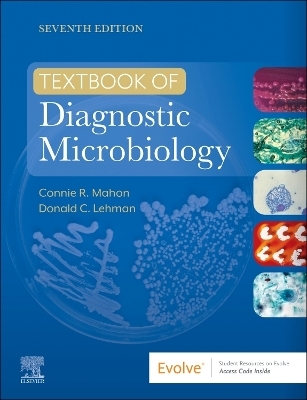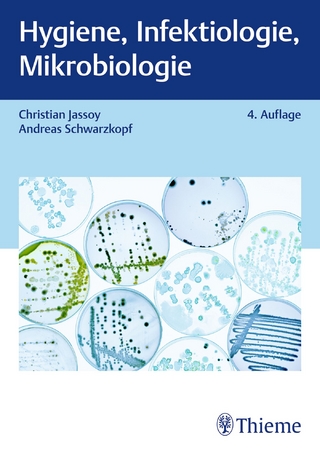
Textbook of Diagnostic Microbiology
Elsevier - Health Sciences Division (Verlag)
978-0-323-82997-7 (ISBN)
Building-block approach encourages you to use previously learned information in mastering new material.
Full-color photographs and photomicrographs make it easier to understand and apply diagnostic microbiology concepts.
Case studies describe clinical and laboratory findings, offering opportunities to correlate observations with possible etiologic agents and to build critical thinking and problem-solving skills.
Hands-on procedures in the appendices describe techniques used in the lab setting.
Issues to Consider boxes list important points to think about while reading the chapter.
Case Checks in each chapter highlight specific points in the text and show how they connect to case studies.
Bolded key terms with abbreviations are listed at the beginning of each chapter, showing the most important and relevant terms in each chapter.
Learning Objectives at the beginning of each chapter supply you with a measurable learning outcome to achieve by completing the material.
Points to Remember sections at the end of each chapter provide a bulleted list of key concepts.
Learning Assessment Questions at the conclusion of each chapter help you to think critically and to evaluate how well you have mastered the material.
Agents of Bioterror and Forensic Microbiology chapter provides the most current information about these important topics.
Lab manual on the Evolve website reinforces concepts with real-life scenarios and review questions.
Glossary at the end of the book supplies you with a quick reference for looking up definitions of key terms.
NEW! Information about SARS-CoV-2 and COVID-19 is added to this edition.
NEW! Updated content is included throughout the book, and several chapters are reorganized and refocused.
NEW! Enterobacteriaceae chapter is updated.
Part 1: Introduction to Clinical Microbiology Chapter 1: Bacterial Cell Structure, Physiology, Metabolism, and Genetics Chapter 2: Host-Parasite Interaction Chapter 3: The Laboratory Role in Infection Control Chapter 4: Control of Microorganisms: Disinfection, Sterilization, and Microbiology Safety Chapter 5: Performance Improvement in the Microbiology Laboratory Chapter 6: Specimen Collection and Processing Chapter 7: Microscopic Examination of Materials from Infected Sites Chapter 8: Use of Colony Morphology for the Presumptive Identification of Microorganisms Chapter 9: Biochemical Identification of Gram-Negative Bacteria Chapter 10: Immunodiagnosis of Infectious Diseases Chapter 11: Applications of Molecular Diagnostics Chapter 12: Antibacterial Mechanisms of Action and Bacterial Resistance Mechanisms Chapter 13: Antimicrobial Susceptibility Testing Part 2: Laboratory Identification of Significant Isolates Chapter 14: Staphylococci Chapter 15: Streptococcus, Enterococcus, and Other Catalase-Negative, Gram-Positive Cocci Chapter 16: Aerobic Gram-Positive Bacilli Chapter 17: Neisseria Species and Moraxella catarrhalis Chapter 18: Haemophilus, HACEK, Legionella and Other Fastidious Gram-Negative Bacilli Chapter 19: Enterobacteriaceae Chapter 20: Vibrio, Aeromonas, and Campylobacter Species Chapter 21: Nonfermenting and Miscellaneous Gram-Negative Bacilli Chapter 22: Anaerobes of Clinical Importance Chapter 23: The Spirochetes Chapter 24: Chlamydia, Rickettsia, and Similar Organisms Chapter 25: Mycoplasma and Ureaplasma Chapter 26: Mycobacterium tuberculosis and Nontuberculous Mycobacteria Chapter 27: Medically Significant Fungi Chapter 28: Diagnostic Parasitology Chapter 29: Clinical Virology Chapter 30: Agents of Bioterror and Forensic Microbiology Chapter 31: Biofilms: Architects of Disease Part 3: Laboratory Diagnosis of Infectious Diseases: and Organ System Approach to Diagnostic Microbiology Chapter 32: Upper and Lower Respiratory Tract Infections Chapter 33: Skin and Soft Tissue Infections Chapter 34: Gastrointestinal Infections and Food Poisoning Chapter 35: Infections of the Central Nervous System Chapter 36: Bacteremia and Sepsis Chapter 37: Urinary Tract Infections Chapter 38: Genital Infections and Sexually Transmitted Infections Chapter 39: Infections in Special Populations Chapter 40: Zoonotic Diseases Chapter 41: Ocular Infections Appendix A: Selected Bacteriologic Culture Media Appendix B: Selected Mycology Media, Fluids, and Stains Appendix C: Selected Procedures Appendix D: Answers to Learning Assessment Questions Glossary
| Erscheinungsdatum | 03.02.2023 |
|---|---|
| Zusatzinfo | 970 illustrations (970 in full color); Illustrations |
| Verlagsort | Philadelphia |
| Sprache | englisch |
| Maße | 216 x 276 mm |
| Gewicht | 2700 g |
| Themenwelt | Medizin / Pharmazie ► Medizinische Fachgebiete ► Mikrobiologie / Infektologie / Reisemedizin |
| Medizin / Pharmazie ► Pflege | |
| ISBN-10 | 0-323-82997-X / 032382997X |
| ISBN-13 | 978-0-323-82997-7 / 9780323829977 |
| Zustand | Neuware |
| Haben Sie eine Frage zum Produkt? |
aus dem Bereich


